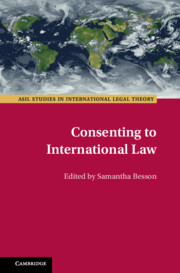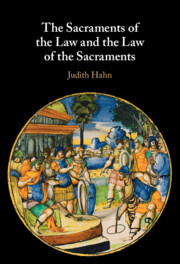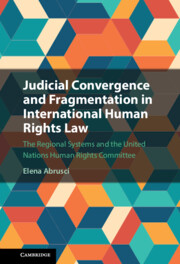Refine search
Actions for selected content:
54 results
7 - Access to Justice in Tennis Disputes
- from Part 2 - Regulatory
-
-
- Book:
- Professional Tennis and Transnational Law
- Published online:
- 07 August 2025
- Print publication:
- 21 August 2025, pp 147-169
-
- Chapter
-
- You have access
- Open access
- HTML
- Export citation
1 - The Expanding Role of Courts in Modern Constitutions
-
- Book:
- Courts and the Body Politic
- Published online:
- 25 July 2025
- Print publication:
- 14 August 2025, pp 1-36
-
- Chapter
- Export citation
19 - Dispute Settlement, Particularly Adjudication and Arbitration
-
-
- Book:
- The Cambridge History of International Law
- Published online:
- 01 May 2025
- Print publication:
- 29 May 2025, pp 612-649
-
- Chapter
- Export citation
8 - New Horizons of Mediation
- from Part III - Legal Metamorphosis?
-
- Book:
- Vanishing Legal Justice
- Published online:
- 20 March 2025
- Print publication:
- 03 April 2025, pp 164-172
-
- Chapter
- Export citation
5 - Complementarity, Structure, and Ambivalence
- from Part II - Remedies beyond the CJEU
-
-
- Book:
- Redressing Fundamental Rights Violations by the EU
- Published online:
- 21 December 2024
- Print publication:
- 12 December 2024, pp 123-154
-
- Chapter
-
- You have access
- Open access
- HTML
- Export citation
8 - The Final Outcome of the Case
-
- Book:
- From Colonial Cuba to Madrid
- Published online:
- 14 November 2024
- Print publication:
- 21 November 2024, pp 257-284
-
- Chapter
- Export citation
Chapter Four - US Litigation by Chinese Companies
-
- Book:
- Negotiating Legality
- Published online:
- 13 June 2024
- Print publication:
- 27 June 2024, pp 124-158
-
- Chapter
- Export citation
10 - The International Court of Justice
-
- Book:
- International Organizations
- Published online:
- 17 May 2024
- Print publication:
- 06 June 2024, pp 220-247
-
- Chapter
- Export citation
23 - Commercial Dispute Resolution and AI
- from Part III - Corporate and Commercial Law
-
-
- Book:
- The Cambridge Handbook of Private Law and Artificial Intelligence
- Published online:
- 21 March 2024
- Print publication:
- 28 March 2024, pp 511-533
-
- Chapter
- Export citation
12 - Trust Law and AI
- from Part I - Law of Obligations
-
-
- Book:
- The Cambridge Handbook of Private Law and Artificial Intelligence
- Published online:
- 21 March 2024
- Print publication:
- 28 March 2024, pp 270-286
-
- Chapter
- Export citation
3 - Diversity and Bias in Legal Decision-Making
- from Part I - Introduction Chapters
-
-
- Book:
- The Cambridge Handbook of Psychology and Legal Decision-Making
- Published online:
- 22 February 2024
- Print publication:
- 29 February 2024, pp 32-48
-
- Chapter
- Export citation
15 - Autonomy in International Law
- from Part III - Subjects and Institutions of Consent
-
-
- Book:
- Consenting to International Law
- Published online:
- 23 November 2023
- Print publication:
- 07 December 2023, pp 347-368
-
- Chapter
- Export citation

Consenting to International Law
-
- Published online:
- 23 November 2023
- Print publication:
- 07 December 2023

The Sacraments of the Law and the Law of the Sacraments
-
- Published online:
- 09 November 2023
- Print publication:
- 23 November 2023
6 - Foreign Judges in the Macau Special Administrative Region of China
- from Domestic Drivers
-
-
- Book:
- The Cambridge Handbook of Foreign Judges on Domestic Courts
- Published online:
- 26 October 2023
- Print publication:
- 09 November 2023, pp 88-101
-
- Chapter
- Export citation
1 - An Introduction to Foreign Judges on Domestic Courts
-
-
- Book:
- The Cambridge Handbook of Foreign Judges on Domestic Courts
- Published online:
- 26 October 2023
- Print publication:
- 09 November 2023, pp 1-30
-
- Chapter
- Export citation
10 - Third-Party Peacemaking and Peacekeeping
- from Part IV - Diplomacy and Conflict
-
-
- Book:
- Understanding War and Peace
- Published online:
- 06 July 2023
- Print publication:
- 20 July 2023, pp 300-336
-
- Chapter
- Export citation
4 - The Institutional Context of the International Court of Justice
- from Part I - The Role of the ICJ
-
-
- Book:
- The Cambridge Companion to the International Court of Justice
- Published online:
- 18 May 2023
- Print publication:
- 06 April 2023, pp 86-100
-
- Chapter
- Export citation
62 - Sociology of Arbitrators
- from Part XIII - Arbitration and Related Fields
-
-
- Book:
- Cambridge Compendium of International Commercial and Investment Arbitration
- Published online:
- 18 February 2023
- Print publication:
- 02 March 2023, pp 1892-1909
-
- Chapter
- Export citation

Judicial Convergence and Fragmentation in International Human Rights Law
- The Regional Systems and the United Nations Human Rights Committee
-
- Published online:
- 22 December 2022
- Print publication:
- 05 January 2023
